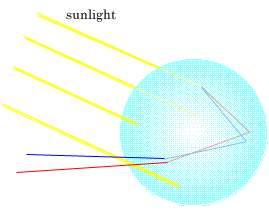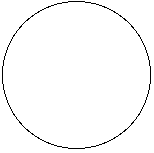Submodule 4: Rainbows Page 3
Steve Beeson, Arizona State University
How much light does each raindrop contribute?

Do you remember from our experiment what the spectrum from our "mock raindrop" looked like? Why was it a complete circle around the flask? The light wasn't only shining on one little area of the raindrop; the whole front side was illuminated by the light. We had white light coming in on the left side and colored light coming out on the right side (between 40� and 42�) as in the image above.
Similarly, we had white light coming in on the right side and exiting as colored light on the left side. Actually, this was happening at every point on the sunward side of the raindrop: white light entering from the bottom, exiting in color from the top, and vice versa.
If light shines on one side of a mirrored spherical surface, what do you think the reflection will look like?

We see a circle of light created by the parallel light beams reflecting and refracting through a spherical surface.
How does this apply to a big rainbow with many raindrops?
Each raindrop is emitting the spectrum of colors, but surely a normal rainbow is far too large to be created by just one raindrop! We find that we are seeing only one color
(indeed, only one tiny beam of light!) from each raindrop. We must be seeing the refracted light contributed from many different raindrops.

Here we can see that it's the raindrops lower down that contribute blue and green light and the raindrops higher up that contribute red and yellow light.
So if a single raindrop doesn't make a rainbow, how do we get a "bow" out of many raindrops?
 Modules
Modules
 Light & Optics
Light & Optics
 Submodule 4
Submodule 4
 Readings
Readings
 PiN Homepage
PiN Homepage
 ACEPT
ACEPT
 Glossary
Glossary
 Help
Help